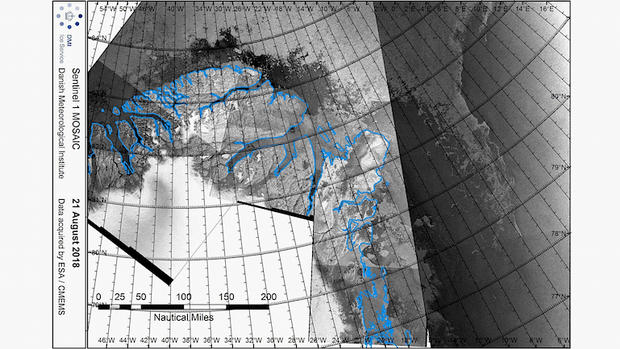The Arctic's 'Last Bastion' Of Sea Ice Is Breaking Up For The 1st Time
GREENLAND (CNN) - The sea ice off the coast of northern Greenland is normally some of the thickest in the entire Arctic, with ridges of ice piled as high as 70 feet in some places.
And despite the rapid retreat of sea ice across the region due to climate change, this harsh corner of the globe was expected to be the last to retain year-round sea ice cover.
But recent satellite imagery shows that some of the Arctic's oldest ice has been replaced by miles of open water for the first time on record, surprising scientists and ice monitors.
"This was the area that was seen as the last bastion, where we'd see these changes come last, but they've arrived," said Walt Meier, a senior research scientist with the National Snow and Ice Data Center.
- How The Breakup Happened
Sea ice off of northern Greenland is much thicker than elsewhere in the Arctic because, according to Meier, as ice drifts across the Arctic from Siberia, it is compacted against Greenland's rugged coast.
But this year has shown that even the densest sea ice is not impervious to high temperatures.
In late February and early March, summerlike heat and winds out of the south resulted in a similar ice breakup in the region.
"We saw this occur first earlier this year ... which is really particularly unusual in the sense that it was still winter there, so it's generally very cold."
Keld Qvistgaard, a senior ice adviser with the Greenland Ice Service, says it's possible that the current breakup is connected to the one that appeared in February. But the current melt is far more extensive than what was spotted in late winter, and much larger than he's ever seen before.
"In this case, [the open water is] 20-30 miles wide and goes all the way from the northeast off Greenland to the northern tip, and even further west," Qvistgaard said. "I've been in this business for 26 years and I don't recall that I've seen a breakup this big."
- What This Means For The Future Of The Arctic
Though the current sea ice breakup is unprecedented, Meier and Qvistgaard stressed that this is only a single event in a relatively small geographic area.
But it is in line with other changes to ice cover that scientists have observed in the region.
"It really is another indication of the changed Arctic, an Arctic that is covered by more seasonal ice -- ice that melts away every summer, thinner ice cover and a more mobile ice cover," Meier said.
In general, the loss of sea ice does have implications for the global climate.
As sea ice melts, sunlight entering the atmosphere that would normally be reflected back into space is instead absorbed by the dark blue of the open ocean, further heating the water and the surrounding air. This kick-starts a vicious cycle, resulting in even more melting of sea ice and ocean heat absorption.
"Long-term, it's clear that the ice is more broken up and thinner and weaker, so this is probably going to happen again at least from time to time. How often? It's hard to say," Meier said. "This will still probably be the last area to lose ice completely during the summer, but it's more vulnerable than we had previously thought."
(The-CNN-Wire™ & © 2018 Cable News Network, Inc., a Time Warner Company contributed to this report. All rights reserved.)




